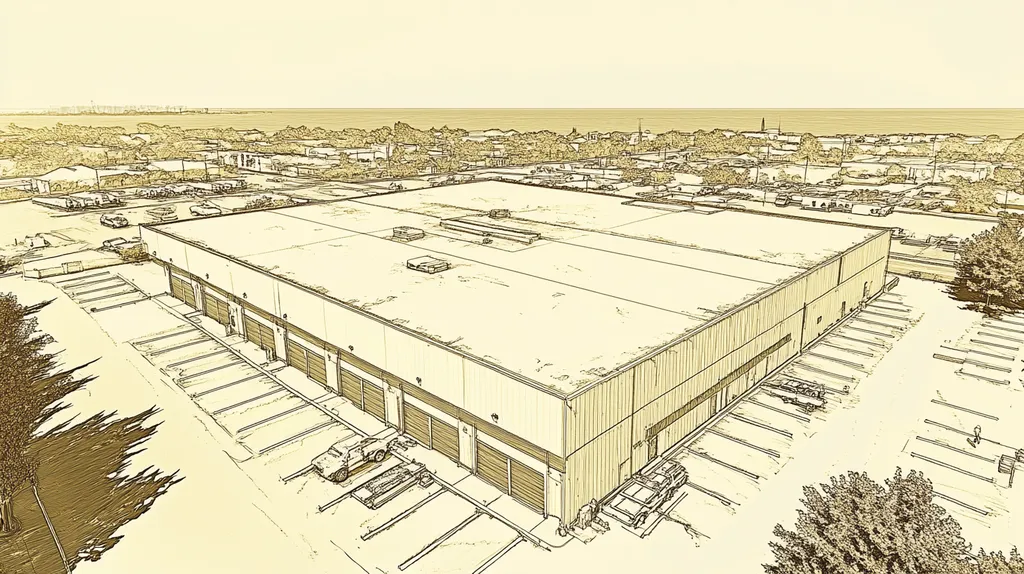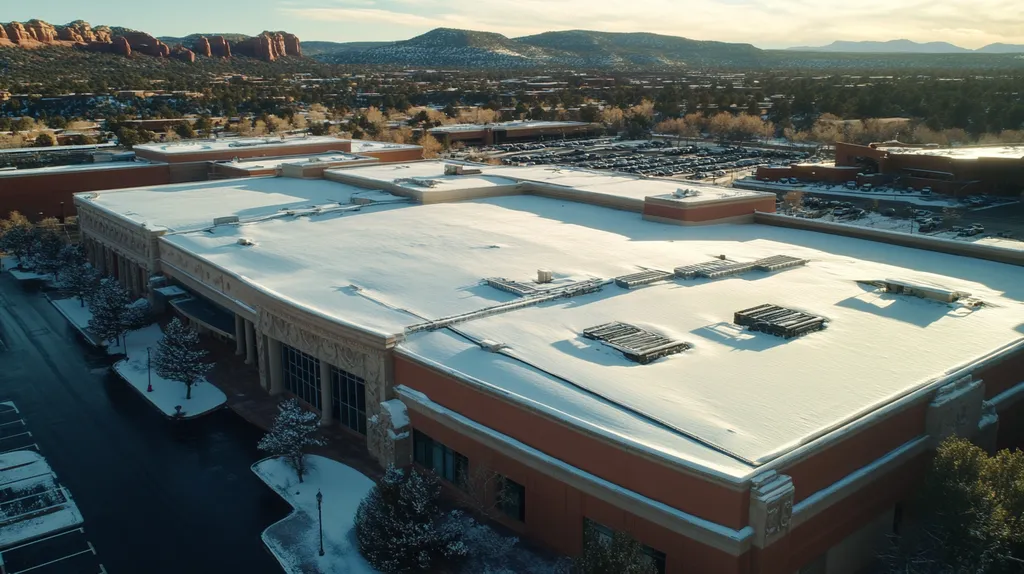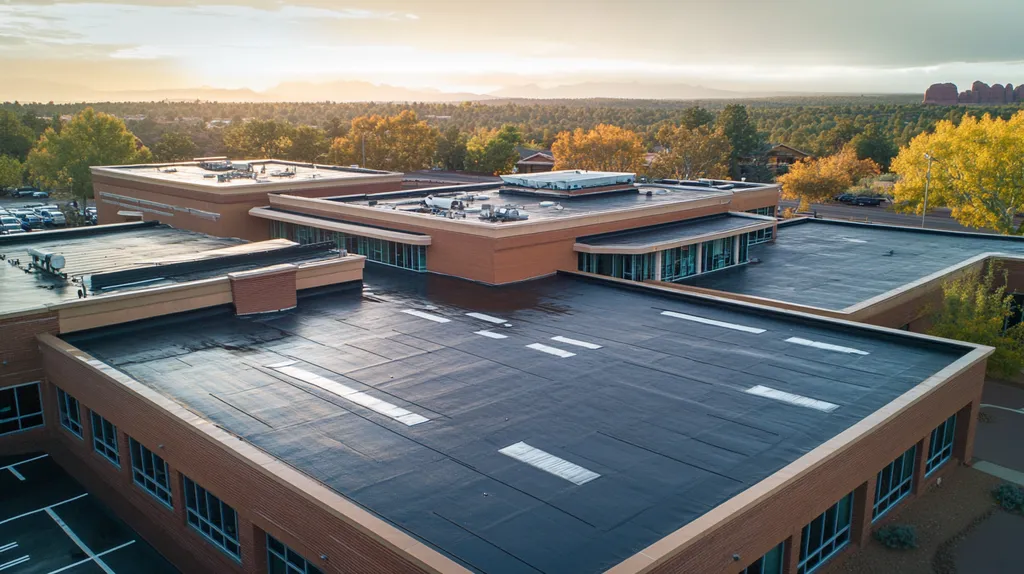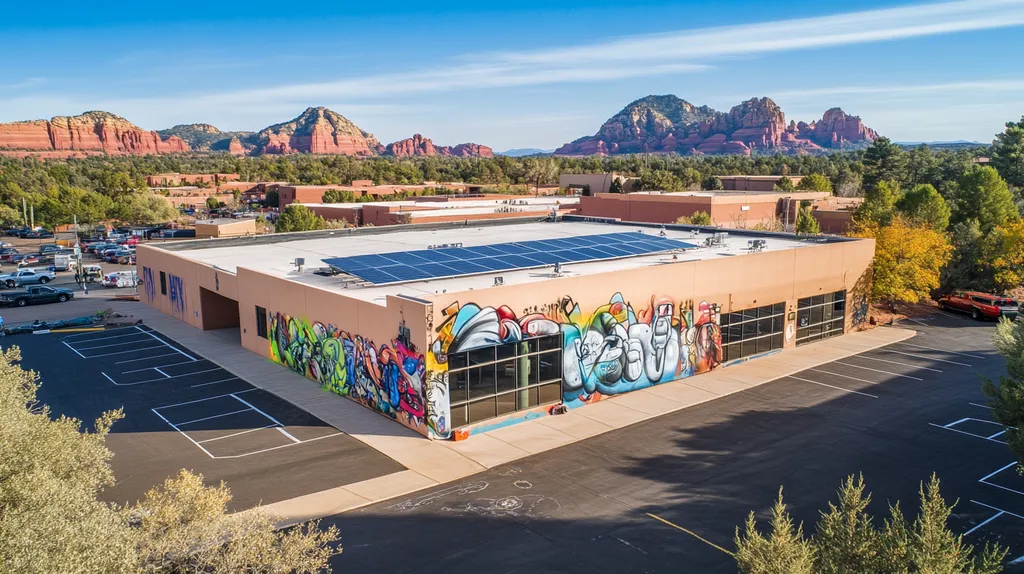In today’s commercial roofing industry, the stakes have never been higher. Studies show that up to 70% of roofing failures stem from improper installation by uncertified workers, resulting in billions in damage annually.
For property owners and facility managers, understanding worker certifications isn’t just about compliance—it’s about protecting their investment and ensuring safety.
This comprehensive guide examines the critical certifications required in commercial roofing, from OSHA safety requirements to manufacturer-specific credentials, providing actionable insights for making informed decisions about roofing projects.
SECTION 1: FUNDAMENTAL CONCEPTS
In the dynamic landscape of commercial roofing, securing the right certifications is more than a mere achievement; it serves as a cornerstone for safety, quality, and regulatory adherence. Alarmingly, nearly 20% of roofing failures can be traced back to subpar workmanship, frequently performed by unqualified workers. By prioritizing certified professionals, property owners enhance the durability of their roofs while safeguarding their properties against potential disasters.
Importance of Certifications in Roofing
In roofing, certifications play a crucial role in upholding industry standards and ensuring high-quality workmanship. They act as evidence that workers possess the appropriate training and skills to execute roofing tasks safely and efficiently. For property owners, hiring certified roofers not only instills confidence but also assures compliance with established regulations and standards.
Furthermore, certifications can significantly reduce liability. If a roofing contractor’s negligence causes damage, having a certified contractor provides property owners with an added layer of protection. This consideration is critical, as any roofing failure can lead to substantial financial loss and create serious safety risks.
As the industry evolves, many certifications now emphasize sustainable practices. Roofers who are trained in green roofing solutions not only support environmental initiatives but also help property owners save on energy expenses.
In today’s competitive market, a contractor’s certification can be a distinguishing factor. Property owners are likely to prefer a certified roofing company over one lacking credentials, showcasing the clear benefits of certifications for both workers and businesses.
Types of Certifications for Roofers
An array of certifications exists, each designed to validate specific skills and knowledge in roofing. One notable provider, the National Roofing Contractors Association (NRCA), offers comprehensive training and certification programs that cover essential roofing aspects, including safety protocols and technical proficiency.
In addition to general certifications, there are specialized programs focusing on specific techniques, such as green roofing or flat roofing systems. This specialization allows roofers to highlight their expertise in niche areas, making them more attractive to property owners seeking tailored solutions.
Manufacturers also provide certifications, which are often required for contractors to install certain roofing materials. These certifications ensure that roofers understand the best practices and warranties tied to those materials, further protecting property owners’ interests.
As technological advancements emerge, new certifications will continue to develop. Staying informed about the latest roofing technologies through certification ensures that roofers remain competitive and continuously improve the quality of their work.
Industry Standards and Regulations
The roofing industry adheres to numerous standards and regulations set forth by organizations such as the Occupational Safety and Health Administration (OSHA) and the American National Standards Institute (ANSI). These organizations establish crucial safety guidelines, ensuring that roofing work is conducted without risking the well-being of workers and building occupants.
Complying with these standards not only boosts workplace safety but also fosters a culture of responsibility and accountability. Workers educated under these regulations become more aware of potential hazards and best practices, leading to safer working environments.
Moreover, strict adherence to industry standards can positively impact insurance costs for commercial properties. Insurance providers often offer lower premiums for buildings maintained by certified roofers, considering such buildings present a lower risk for incidents and claims.
For property owners, grasping these regulations is essential. Ensuring that contractors adhere to these standards contributes to superior workmanship and ultimately protects their investments.
SECTION 2: SYSTEM COMPONENTS
Understanding certifications for commercial roofing workers is vital for property owners and facility managers. Incomplete or improper installation can lead to significant repairs and serious safety hazards. By ensuring roofers are qualified through proper certifications, property owners can have confidence that complex materials are handled safely and installation techniques are executed effectively. This section outlines key certifications and their importance for successful roofing projects.
OSHA Safety Certifications and Requirements
The Occupational Safety and Health Administration (OSHA) establishes essential safety standards for commercial roofing workers. Without adequate training, workers may expose themselves and others to perilous situations. OSHA training emphasizes critical areas such as fall protection, hazard communication, and the use of personal protective equipment, all aimed at minimizing accidents on the job.
OSHA certifications can differ based on state and local laws, with many contractors opting for the 10-hour or 30-hour training courses. These programs impart crucial safety protocols that impact both project costs and worker safety directly.
Before hiring roofing contractors, property owners should confirm that they meet OSHA requirements. This step ensures that workers are equipped to handle job-related challenges and reduces the risk of accidents that could result in liability issues.
Additionally, holding OSHA certifications can provide contractors with a competitive advantage. Contractors that employ certified workers demonstrate a commitment to safety, enhancing their business reputation and gaining client trust.
Manufacturer-Specific Certifications (GAF, CertainTeed)
For instance, GAF-certified roofers enjoy exclusive warranty advantages, offering property owners peace of mind that materials are installed according to manufacturer guidelines, thereby maximizing performance.
Moreover, certified contractors are typically required to participate in ongoing education. This continuous learning ensures they are updated on the latest innovations and best practices, significantly reducing the likelihood of installation errors and saving property owners time and costs.
Choosing a manufacturer-certified contractor is a crucial factor for property managers, significantly influencing the durability and reliability of the roofing system.
State and Local Licensing Requirements
In conjunction with federal and manufacturer certifications, state and local licensing plays an essential role in roofing. Each state enforces specific regulations that contractors must meet, ensuring they are adequately skilled in roof installation and maintenance.
Licensing requisites may include background checks, proof of insurance, and passing necessary exams. These regulations help filter out unqualified contractors, aiding property owners in hiring competent professionals.
For instance, specific states may require roofers to hold licenses in general contracting along with roofing-specific training. This comprehensive approach educates workers on diverse roofing systems, safety protocols, and local building codes.
It is crucial for property managers to verify the licensing status of roofing contractors. Failure to comply with these regulations can result in fines and possibly invalidate warranties, jeopardizing property investments.
SECTION 3: IMPLEMENTATION METHODS
In the fast-paced world of commercial roofing, obtaining certifications is no longer a luxury—it’s a necessity. With growing safety regulations and rising expectations from clients, property owners must prioritize hiring certified workers. Research shows that certified roofing crews not only perform better but also maintain lower injury rates, leading to significant savings in the long run. This section provides critical steps for acquiring OSHA safety certification, achieving GAF Master Elite Certification, and understanding the importance of obtaining state roofing licenses.
Steps to Obtain OSHA Safety Certification
Securing OSHA safety certification is crucial for any commercial roofing operation. This certification ensures that workers are well-versed in safety protocols, significantly diminishing the risk of workplace accidents. The first step is selecting an OSHA-approved training program, which can often be completed online or in a classroom setting.
Next, businesses must ensure that all workers complete the training successfully. After training, each employee needs to pass a written exam to receive their OSHA card. It’s important for companies to stay up to date with OSHA’s guidelines, as regulations may change over time.
Once certified, companies should incorporate ongoing safety training into their regular operations. Regular refresher courses keep safety at the forefront for employees, building a culture that prioritizes workplace safety across all tasks. This commitment to safety can reduce overall liabilities.
By investing in OSHA certification, property owners benefit from a more knowledgeable workforce that actively minimizes risks and enhances project efficiency.
Process for GAF Master Elite Certification
Achieving GAF Master Elite Certification distinguishes a commercial roofer in the competitive roofing industry. This prestigious recognition provides essential credibility, making it easier for property owners to choose qualified contractors. To start, contractors need to apply through GAF’s website, showcasing their experience and appropriate licensing.
Once the application is approved, contractors must undergo extensive training, which includes both technical education and specific training on GAF systems. Additionally, contractors are required to maintain a good standing with both GAF and the Better Business Bureau.
Upon successfully meeting all requirements, contractors receive Master Elite status, granting them access to exclusive GAF products and warranties. This added value translates into not just savings, but also quality assurance for property owners.
Master Elite contractors must renew their certification at set intervals, ensuring they keep pace with the latest industry practices. This commitment ensures that property owners receive the highest quality service possible.
Earning State Roofing Licenses and Certifications
Obtaining state roofing licenses and certifications is essential for legal compliance and establishing trust in the industry. Each state has unique requirements that contractors must fulfill, often including examinations and proof of past experience. Property owners should verify that their roofing contractors hold the necessary licenses to avoid potential legal complications.
The process generally begins with submitting an application to the state’s licensing board. This application may require documentation such as proof of insurance and records of prior work history. After approval, contractors typically need to pass an examination that tests their roofing knowledge and practices.
Furthermore, some states mandate continuing education to keep licenses current. This ensures that contractors are updated on the latest building codes and safety practices, enhancing service quality.
For property owners, confirming that roofing contractors have the appropriate licenses reduces risks associated with unqualified work. Adherence to these regulations guarantees high standards and secures long-term investments in roofing projects. (source: GetJobber)
SECTION 4: MAINTENANCE REQUIREMENTS
In the realm of commercial roofing, maintenance is far from a mere check-up; it’s a critical safeguard against potential disasters. Effective maintenance not only prevents costly repairs but is also fundamental for ensuring compliance with safety regulations. For example, falls remain the leading cause of fatalities in construction—underscoring the need for rigorous maintenance protocols. This section delves into the necessity of regular inspections, the upkeep of fall protection systems, and the importance of keeping certifications and training current.
Regular Inspections for Safety Compliance
Regular inspections are a cornerstone of maintaining safety compliance within commercial roofing systems. These inspections uncover potential issues, such as leaks or structural vulnerabilities, before they can escalate into bigger, costlier problems. Property owners should aim for thorough inspections at least twice a year, ideally timed for spring and fall to catch any weather-related wear and tear.
Certified roofing professionals should carry out these inspections, as their expertise allows them to recognize compliance concerns effectively. They will examine critical areas like flashing integrity, surface conditions, and drainage efficiency. Documenting these findings is essential; it not only provides a clear timeline of issues but also aids in future maintenance planning.
Moreover, maintaining an inspection log can help identify recurring problems, allowing property owners to address root causes proactively. By making regular inspections a priority, property owners can mitigate risks while extending the lifespan of their roofing systems. Ultimately, this approach reflects both regulatory compliance and dedication to industry best practices, reinforcing a culture of safety.
Maintenance of Fall Protection Systems
Fall protection systems are indispensable, requiring diligent maintenance to ensure they function correctly. These systems can significantly decrease the likelihood of worker injuries on commercial rooftops. Routine maintenance should include checking harnesses, guardrails, and anchor points for any signs of wear or damage.
Property owners should be aware that OSHA mandates specific fall protection requirements for roofing. Non-compliance can lead to hefty fines and increased liability exposure. Therefore, regular maintenance of these systems isn’t merely advantageous—it’s a legal obligation.
It’s also crucial to train workers on how to properly utilize fall protection equipment. Regular evaluations of training sessions help ensure that employees remain knowledgeable about safety practices and equipment use. A well-trained workforce is a safer workforce.
Additionally, keeping documented records of maintenance activities and training fosters accountability. This not only bolsters safety compliance but also cultivates a sense of vigilance within roofing operations. Consistent maintenance of fall protection systems safeguards workers while enhancing overall job site safety.
Updating Certifications and Training
In the ever-evolving commercial roofing sector, keeping certifications and training up to date is essential. With new materials and technologies on the market, best practices for installation and maintenance also shift. Property owners should routinely check that their roofing teams possess valid certifications and have participated in recent training sessions.
Industry standards, such as those provided by the National Roofing Contractors Association (NRCA), guide ongoing education initiatives. This continuous learning not only sharpens workers’ skills but also ensures adherence to safety compliance standards.
Furthermore, recent training sessions equip roofing professionals with information on the latest safety protocols and installation techniques. This is vital for reducing risks related to outdated methods that could result in accidents or diminish roof performance.
Investing in ongoing education for roofing personnel showcases a commitment to safety and excellence. It also strengthens trust between property owners and service providers by maintaining high standards of workmanship. Such investments ultimately pay off by enhancing roof durability and ensuring safety compliance.
SECTION 5: PERFORMANCE METRICS
In the commercial roofing industry, establishing clear performance metrics is essential for enhancing safety, operational efficiency, and customer satisfaction. Alarmingly, studies indicate that 65% of roofing incidents arise from insufficient training. When companies fail to implement measurable standards for safety compliance, they jeopardize worker safety and expose themselves to financial penalties. This section explores the critical performance metrics that evaluate the impact of certifications not only on business operations but also on client trust.
Measuring Safety Compliance and Training
Safety compliance is paramount in commercial roofing, significantly influencing both employee protection and project outcomes. To gauge effectiveness, companies should implement routine safety audits that assess training programs and adherence to OSHA regulations. Key metrics include the frequency of safety incidents, safety training completion rates, and scores from audits.
These metrics can highlight weaknesses in training initiatives. For example, if incident rates remain elevated despite comprehensive training efforts, it may indicate a need to revise training material or delivery methods. A robust measurement practice empowers businesses to take corrective actions that not only boost safety but also enhance overall productivity.
Additionally, it’s crucial to regularly update training certifications to align with evolving industry standards. Monitoring certification renewals and evaluating the relevance of training content enables workers to stay well-prepared. This proactive approach promotes a culture of safety within the organization.
By prioritizing metrics focused on safety compliance, roofing contractors can ensure an environment that values worker well-being and project success, ultimately fostering greater client trust and project longevity.
Evaluating Certification Impact on Business
Understanding how certifications influence business performance is vital for cultivating competitive advantages. Research suggests that companies employing certified workers typically complete projects 15% faster than their untrained counterparts. This statistic underscores the direct link between certifications and operational efficiency.
Moreover, certified professionals generally produce higher-quality work, which translates into fewer callbacks and warranty claims. Tracking metrics such as return on investment (ROI) from certification programs can shed light on their financial advantages. By analyzing project timelines and defect rates, businesses can quantify the cost savings associated with utilizing certified workers.
Retention rates among certified employees are another critical metric. Higher retention often indicates job satisfaction and engagement, essential for maintaining project continuity and expertise. Consequently, companies can benefit from improved performance and tighter project timelines.
Ultimately, assessing the impact of certifications aids in strategic planning and enhances marketing efforts. As property owners increasingly seek contractors with recognized certifications, this becomes a crucial differentiator in a competitive landscape.
Customer Satisfaction and Trust Metrics
Customer satisfaction metrics are closely tied to the level of certification among roofing workers. Companies that prioritize certification often report higher satisfaction ratings from clients. A survey indicated that 78% of customers felt more confident working with certified professionals.
Measuring customer feedback using surveys or net promoter scores (NPS) provides actionable insights into service quality and customer perceptions. Gathering input on project execution, communication, and overall satisfaction can reveal areas for improvement while highlighting the value of certifications.
Additionally, tracking repeat business and referral rates serves as further indicators of customer trust. A greater proportion of repeat clients typically reflects that a company’s commitment to quality and certification is yielding positive results. This trust is vital for establishing long-term relationships and securing larger contracts.
As awareness of certification importance grows among clients, their expectations will continue to rise. Companies aligning their performance metrics with customer satisfaction will be better positioned for sustainable growth and competitive success in the roofing industry.
SECTION 5: PERFORMANCE METRICS
Establishing effective performance metrics in the commercial roofing industry is crucial for promoting safety, efficiency, and customer satisfaction. A concerning study revealed that 65% of roofing incidents are linked to insufficient training. When companies do not set clear standards for safety compliance, they expose their workers to unnecessary risks, along with the potential for financial penalties. This section delves into the performance metrics that are vital for assessing the impact of certifications on business operations and building client trust.
Measuring Safety Compliance and Training
Prioritizing safety compliance is essential in commercial roofing, directly affecting both employee protection and project outcomes. Companies should implement regular safety audits to evaluate the effectiveness of training and adherence to OSHA regulations. Useful metrics include the frequency of safety incidents, completion rates for safety training, and the results of safety audits.
By analyzing these metrics, companies can identify gaps in their training programs. For instance, if incident rates continue to be high despite training efforts, it may be time to reevaluate the training material or presentation methods. A strong measurement practice empowers businesses to correct issues promptly, enhancing both safety and productivity.
Additionally, it is important for training certifications to be routinely updated to meet evolving industry standards. Keeping track of certification renewals and assessing the relevance of training content can help ensure that workers are equipped with vital skills. This proactive approach cultivates a safety-first culture across the organization.
By focusing on metrics that highlight safety compliance, roofing contractors can foster an environment that values both worker well-being and project success. Ultimately, this leads to increased client confidence and long-term viability in roofing projects.
Evaluating Certification Impact on Business
Understanding how certifications affect business performance is vital for gaining a competitive edge. Research shows that companies that employ certified workers can complete projects 15% faster than those without such credentials. This statistic underscores the tangible connection between certifications and operational efficiency.
Moreover, certified professionals tend to deliver higher-quality work, resulting in fewer callbacks and warranty claims. Analyzing metrics such as return on investment (ROI) from certification programs can provide insights into their financial advantages. Tracking project completion times and defect rates allows businesses to quantify the cost savings associated with leveraging certified workers.
Retention rates among certified employees also serve as an essential business metric. High retention often reflects improved job satisfaction and engagement, which are critical for maintaining workflow continuity and expertise. Consequently, companies can benefit from tighter project timelines and overall enhanced performance.
Ultimately, assessing the influence of certifications helps with strategic planning as well as marketing initiatives. Property owners increasingly seek contractors with recognized certifications, making this a crucial differentiator in a competitive market.
Customer Satisfaction and Trust Metrics
Metrics for customer satisfaction closely correspond to the degree of certification among roofing workers. Companies that prioritize hiring certified professionals generally report higher satisfaction ratings from clients. An independent survey found that 78% of customers expressed greater confidence when working with certified professionals.
Collecting customer feedback through surveys or net promoter scores (NPS) can yield actionable insights into service quality and client perceptions. Synthesizing feedback related to project execution, communication, and overall satisfaction allows companies to identify areas for improvement while reinforcing the value of certifications.
Additionally, monitoring rates of repeat business and referrals can serve as further indicators of customer trust. A higher percentage of repeat clients often signals that a company’s commitment to quality and certification is yielding positive outcomes. This trust is essential for establishing long-term relationships and securing larger contracts.
As client awareness of certification importance grows, so too will their expectations. Businesses that align their performance metrics with customer satisfaction will be well-positioned for sustainable growth and a competitive edge in the roofing industry.
Looking Ahead
With roofing failures costing businesses over $2 billion annually, the importance of proper worker certification has never been more critical.
Studies show that certified commercial roofers complete projects 40% faster while reducing warranty claims by up to 60%.
As building codes become increasingly complex and new roofing technologies emerge, maintaining current certifications will be essential for contractor success and property protection.
The future of commercial roofing belongs to companies that prioritize ongoing certification and training, creating documented safety protocols and maintaining rigorous quality standards.
For property owners and facility managers, choosing certified roofing professionals isn’t just about compliance—it’s about securing their investment and ensuring long-term building protection for decades to come.
FREQUENTLY ASKED QUESTIONS
Q. Why are certifications important for commercial roofing workers?
A. Certifications are crucial as they ensure that workers are trained and compliant with industry standards, enhancing safety and quality. Hiring certified professionals mitigates risks of errors and potential accidents, protecting property investments. This proactive measure ultimately leads to a safer environment and longer-lasting roofs.
Q. What specific OSHA certifications should commercial roofers hold?
A. Commercial roofers should ideally hold 10-hour or 30-hour OSHA safety certifications. These programs educate workers on critical safety protocols, including fall protection and hazard communication. Ensuring that contractors meet these requirements significantly minimizes the risk of workplace accidents and complies with legal standards.
Q. How can I verify a roofing contractor’s certifications?
A. You can verify a contractor’s certifications by asking for copies of their credentials and checking with respective certifying organizations. Additionally, many manufacturer-specific certifications can be validated through the manufacturer’s website. Confirming these details ensures that you’re hiring qualified professionals for your commercial roof.
Q. What are the benefits of hiring GAF Master Elite contractors?
A. Hiring GAF Master Elite contractors guarantees access to superior products and extended warranty options. These contractors undergo rigorous training and maintain high standards, ensuring quality installation of roofing systems. This commitment can lead to enhanced durability and performance for your commercial roof.
Q. How often should I schedule roofing inspections for my commercial roof?
A. It’s advisable to schedule roofing inspections at least twice a year, preferably in spring and fall. These inspections help identify and address potential issues early on, thus extending the lifespan of your roof. Regular check-ups also ensure compliance with safety regulations and maintain quality workmanship.
Q. How can I maintain compliance with safety regulations?
A. Maintain compliance by regularly updating training and certifications for your roofing staff. Conduct routine safety audits to identify areas for improvement and provide ongoing education to reinforce safety practices. Keeping detailed records of training and inspections aids in meeting regulatory requirements.
Q. What performance metrics should I track for roofing contractors?
A. Important metrics to track include safety incident rates, training completion rates, and customer satisfaction scores. Monitoring these metrics enables you to evaluate the effectiveness of your contractors and identify areas for improvement. This data is vital for ensuring high-quality work and maintaining client trust.










